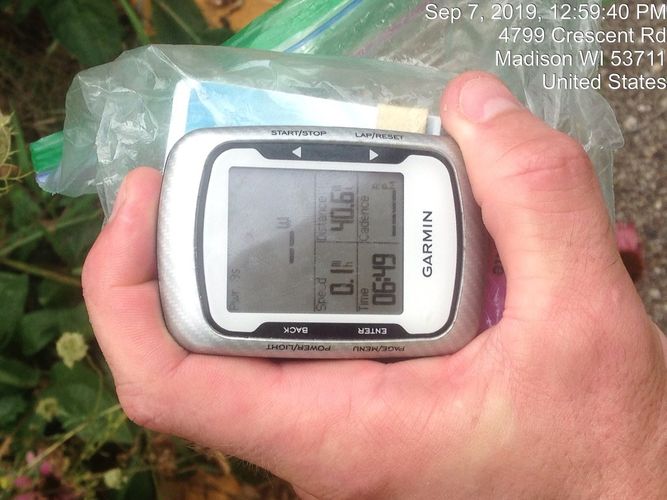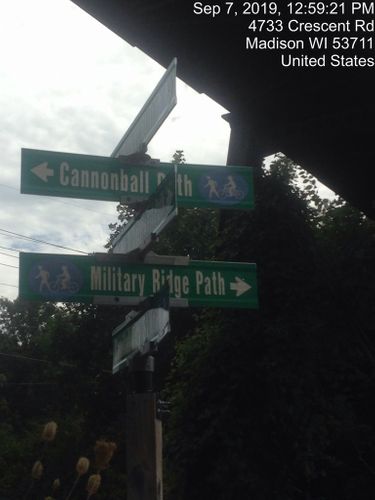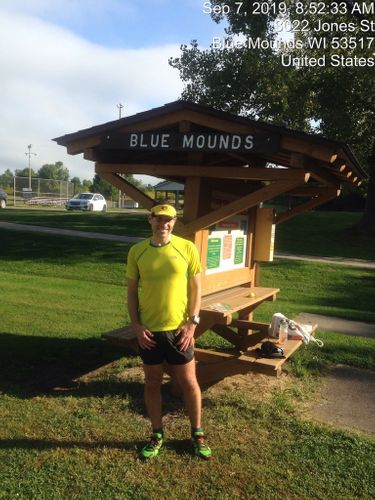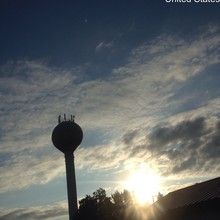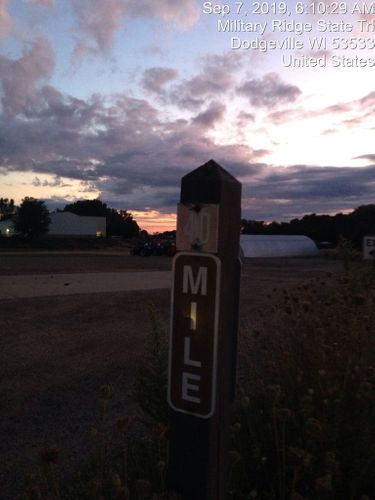Normally, you might expect to turn to this column for some in-depth dissection and practical application of training principles. This time, it will tend toward something a bit more personal, but my hope is this can still provide insight about how you might find inspiration in your own endeavors. The subject will be the thinking that led to the recent completion of a pretty long run. Read on to find out more!
After spending almost 20 years in endurance sports, I’ve had the opportunity to take part in a lot of different activities: road racing, cross racing, time trials, mountain biking, skate and classic cross country skiing, running events from 5k to 50 miles and, once, even a kayak race. Most of the events I did weren’t especially notable, generally local races with small to medium fields. A lot of the VQ athletes have competed in much more prestigious events, things like various Ironmans, Leadville, the Boston Marathon and Lotoja come to mind--and I haven’t done any of them.
When I raced on the bike, it was all about head-to-head competition. To borrow a line from Talladega Nights’ Ricky Bobby, “If you’re not first, you’re last.” But that challenge lost its appeal to me, and as I moved into skiing and running, there was still some competition against the field, but my motivation came more from pushing myself harder than I’d pushed before. Eventually, I reached a point where I was satisfied. I had found the maximum that I felt I could achieve for the amount of work I was willing to put in.
That final point is an important one, it’s quite possible that I could have been better, but I would have had to do more. In the past, I may have been willing to take up that mantle, but as often happens in life, my attention was also being pulled in different directions, so that extra work was no longer appealing or motivating.
We talk a lot about goals at VQ and how important they are to staying on track. To don my coach’s hat for a second, that’s absolutely true. When working with an athlete that has a goal event, we each have some direction that we’re moving. I know how to lay out training to help them develop their fitness for that event, and they are inspired to go out and push themselves to achieve the goal. Swapping back to the athlete’s mindset, as I considered the possible goals, I couldn’t settle on any one thing that I really wanted to do. That brings me to a second crucial point: the goal by itself is not enough, it needs to be a goal that actually matters to you. Why it matters is not important, but when you care about the goal, it will be infinitely easier to stay on track. (A brief sidetrack here, if you can be part of a group pursuing a goal, as we do with our VQ events calendar, it can be even more effective. You still need to care about the goal for your own sake, but the collective energy of the group can help keep you afloat at times when your motivation starts to sink.)
Over the past couple of years, I’ve continued training, but without a lot of purpose or direction. Last spring, however, something popped into my head that actually seemed interesting. The Military Ridge State Trail is a former railroad bed, converted as many were to a recreational trail. It runs from Dodgeville, WI to the southern edge of Madison and right through my hometown, less than a mile from my front door. It’s 40 miles end-to-end. I make frequent use of it for training almost year-round. I wondered if anyone had ever run the entire trail, all at once.
There’s a type of challenge known as “Fastest Known Times” or FKTs. These exist all over the world for segments long and short. Some FKTs are challenged quite prominently, like the record for the Appalachian Trail, for instance. These are not races or organized events in any fashion, but very much an “on your honor” challenge, with certain documentation requirements to ensure that the effort was completed fairly. The Military Ridge Trail certainly does not fall into the same category as some of the major trails, but checking Strava and the primary recordkeeping site for such attempts, FastestKnownTime.com, there didn’t appear to be an established mark. The rest of this article will be a summation of the report I submitted following my attempt. To read it in full, you can find all the details here.
When the idea first came to me to attempt the fastest known time on the Military Ridge Trail, a segment was listed on the website, but there were no records. I found this interesting, if I did it and succeeded, I might not hold just the fastest known time, but also the only known time. I pushed on, building my mileage and quietly planning an attempt for some time in the fall. As the time grew closer, I was looking at a few weekends in September. Since there was no set event date, I could be a bit picky about the weather and was looking for a cooler day with low humidity. The timing began to firm up and I went back to the website to confirm the start and end points of the segment. I learned that another local runner had completed her attempt in June, grabbing the first/only known time for the complete trail. That took some wind out of my sails, but I thought I could still better her time, so I pushed on.
The day arrived, not quite as cool as I had hoped, but the forecast called for cloud cover, which I thought might be especially helpful in the second half of the run, when the trail is more exposed. My wife shuttled me out to my starting point at Dodgeville, and I started running just after 6am--the sun had not yet risen, but it was light enough without a headlamp. From Dodgeville, it’s 9.5 miles to the next town, Ridgeway. The trail was peaceful: tree-lined on both sides with a surface like the Des Plaines River Trail that so many VQers are familiar with, if only it was left untended for a year or so. While there is a gravel base, there is a lot of plant growth coming up through the trail. The first segment was uneventful, as I focused on settling into a pace, trying to keep my heart rate low and eating and drinking regularly.
In Ridgeway, I snapped a picture of the water tower (still backlit by the rising sun, so the town name wasn’t visible) and my GPS watch to document the time and distance. I took a walking break as I came into town, but kept moving as I met my wife to exchange a water bottle and restock my food supply. Leaving town, the trail starts to open up a little bit, but the sun was still low enough that it didn’t feel too hot. Because it was a former railroad grade, all of the uphills and downhills are very gradual, but somehow as you look at the trail stretched out ahead of you, it feels like it’s always going uphill. I stuck to my plan, holding pace, eating and drinking, taking an occasional walking break if I needed to bring my HR down a bit. The trail passes through Barneveld, where I took another water tower photo, and then heads toward the town of Blue Mounds, skirting the lower edge of Blue Mounds State Park where Horribly Hilly finishes.
The last two miles to the stop at Blue Mounds had been slightly uphill (really this time, no tricks) and, despite the grade, I got ahead of myself and was pushing the pace a little harder than I should have. At the trailside shelter in town, now 19 miles in, I met my wife a second time, taking a slightly longer, stationary break. There were some small rocks in my shoes that I wanted to get out before they became too problematic, and the longer break was a chance to recover a bit from the uphill. I was also dreading the next section, 5 miles to Mt. Horeb, as this is where I fell apart during a training run on the trail a few weeks before. Although it’s a net downhill, there are several exposed sections of sustained climbing that really eat away at you after 20 miles. I resolved to be more conservative this time and include more walking breaks to stay under control.
I made it to Mt. Horeb feeling a little better than I had the time before, heart rate was still climbing, but under control. For some perspective, when I started the day, HR was in the mid 140s when running, which feels comfortable. My goal had been to keep it below 150 as long as possible. By Mt. Horeb, it was touching 170 bpm and I was still running at the same pace. I expected this would happen and knew it would be a limiting factor. If I was running a 10k, I might expect my HR to be 170+ and could sustain it for the duration of the race. But when I’m running at an easy effort and seeing my heart rate that high, I find I can only tolerate the sustained effort for so long before I need to back off. Fortunately, after another short break, a little longer walking segment, it came down a little bit and stayed low enough for me to run most of the way to the next stop, a small trailhead on a corner across from a bar and a few houses called Riley.
Riley was just a little beyond 30 miles, I was now 75% done. Surprisingly, I didn’t feel like the effort had been so long, taking it section by section had broken it up enough to keep me engaged. My heart rate was under control, but elevating quickly enough that I knew the I was going to have to slow down over the last 10 miles. I had started the day with a goal of finishing the entire route in 6 hours. Any faster would have been awesome and I would have still been happy being just a little over. My watch read just a little below 4.5 hours. I was still on target, but knowing I was going to have to slow down, I thought the 6-hour finish was out of the question.
As I left, I elected to take a longer walking break, over a mile (most of the previous walking sections had been about a ¼ mile). The first few miles of trail away from Riley were more sheltered, so a bit cooler, and I hoped the longer break would allow my HR to come down. The next section would be 3 miles across a wide open prairie and the clouds that the forecast predicted never materialized. If I could get back to running in the open, I’d get out of the sun as quickly as I could, before going back to walking up a gradual incline that leads into Verona.
I’ve always been able to walk fairly fast, so was keeping the pace brisk to not bleed too much time, around 14-minute miles. Heart rate dropped to the upper 130s, still pretty high for walking, but I was feeling OK and tried to start running again. Within 100 yards, my calves started to cramp, not a full lock-up, but just the twitchiness that precedes complete muscular failure. I immediately shut it down and walked a bit more, then tried to run the rest of that mile, but it was very tenuous. I felt like I was on the edge the entire time, one wrong step and everything would cramp. I hadn’t even reached the incline where I planned to walk yet, which meant crossing the open prairie section took longer than anticipated. Walking though, I wasn’t feeling any cramp indications, so I kept it going and kept eating and drinking, hoping to be able to recover enough to get back to running later.
I made it into Verona, feeling hot, but with only 4 miles left. I stopped at the shelter and took a long drink of cool water from the fountain. Little things like this can taste so good after 6 hours! Crossing Main Street, the trail heads downhill for a while, so I thought this might be a great place to try running again, where the gentle slope should allow me to make some time without having to work too hard. The crampy feeling came up right away. I had to resolve myself to just walking it out. I had been doing the math all along and, at my walking pace, I might still be around 6.5 hours at the finish.
I powered on to where the trail turns to pavement in the last 3 miles and walking fast on this was taking a toll. My feet were sliding around in my shoes and my soles felt like they were on fire. The cramps had started to catch up a bit too and, every once in a while, I would get a twinge while I was walking. Closing in on the finish, the feeling of the day being “long” had also caught up with me: I was ready to be done. The finish was a bit uncertain. The current recordholder had stopped her attempt at a sign where the trail goes over a bridge and ultimately connects with several other trails. I knew this sign, as well as the history of the trail before that bridge had been constructed. An access trail goes to the right of the bridge and dead-ends at the sidewalk adjacent to the road that was the former endpoint of the trail before the bridge was built and the route shifted slightly east to meet it. I planned to finish at the road which felt a little more complete to me than the sign a couple hundred yards before the road.
On top of that, my GPS watch had been gaining a bit of time at each mile marker from the beginning. Although I had covered 39-mile markers, my watch was reading 39.7 miles, so it was basically useless for anything more than the stopwatch at this point. I made it to the sign in question and took a quick glance. I noticed the arrows pointed both directions for the Military Ridge Trail, back where I’d come from and over the bridge. That signage definitely made the trail seem as if it went on and so over the bridge I went. The next major landmark I knew was a five-way intersection of several Madison trails. That had to be the end, but it was another mile away. I was hoping I would come across another sign before I got there with an arrow only pointed in one direction, but alas, it was not until the roundabout that I found it. After 6 hours and 48 minutes, I was done.
This was certainly not a perfect day. I expected my HR to climb and to have to walk a fair amount in the last 10 miles. But I did not expect cramps. Historically, cramps have been a very rare occurrence for me, even in more extreme events and under intense fatigue. There had also not been any warning signs of them prior to the first twinges and I was feeling arguably fresher when I first noticed them than I had been several miles before that long walking break. While it sucked some of the fun out of the FKT attempt, I did not let it deter me, and I pushed on to the end to complete my goal. While it may not be a trail known around the world, it is always an interesting experience to be amongst the few who have taken on a certain challenge. And this challenge in particular is not one I would have picked up if not for the convenience. It was the inspiration that pushed me do more over the past six months than I otherwise would have. The VQ events calendar is a great place to start, but if you find you have goals outside of the norm that are motivating to you, for whatever reason, use that! Let it help you to stay on track and use it to force yourself out the door at those times when you need an extra push.


